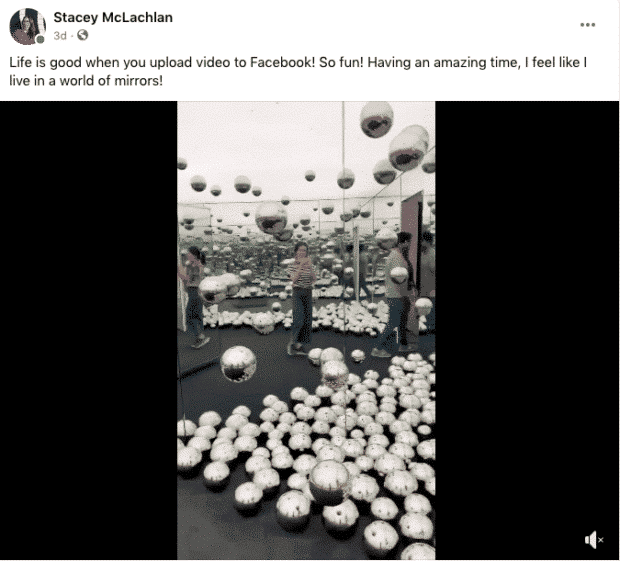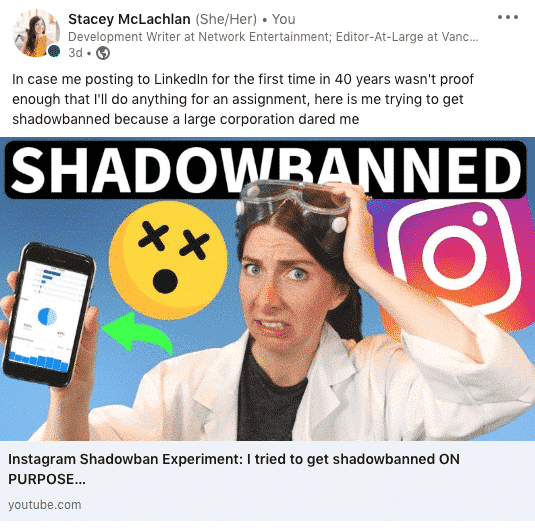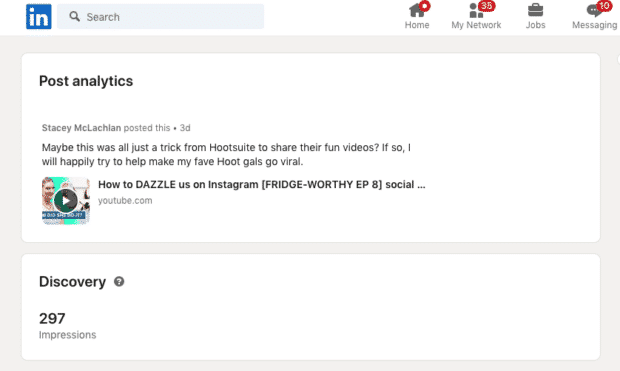Want to share your great video content with the world? These days, you’ve got options. You can post directly to Facebook, create a TikTok, post it to LinkedIn, Tweet it, or make it into an Instagram Story.
Of course, you can always upload your video to YouTube and share the link across all of your social platforms.

Linking to one video instead of uploading multiple versions to multiple platforms seems efficient and effective. But what you want and what social media platforms want isn’t always the same thing, is it?
There’s a theory going around that social networks (mainly Facebook, LinkedIn, and X) give preference to posts that use their native video solutions. In fact, rumor has it that links to YouTube videos might even be punished by other social media platforms’ algorithms.
But here on the Hootsuite blog, we aren’t content to get caught up in the rumor mill. We do our own grinding… of the truth!
That’s why I’m suiting up and heading bravely to the frontlines to see with my own eyes (a.k.a. my social media analytics) if posts with YouTube links really experience lower engagement than native posts.
Keep reading to find out, or check out the video for the TL;DR:
Even though we spend so much time here at Hootsuite researching and analyzing social media algorithms, the behavior of social media sites can still sometimes feel unknowable.
But unlike that brooding new guy at school with the mysterious scar and sad eyes, the inscrutability of Facebook, LinkedIn, Twitter and the rest is usually infuriating, not alluring. Why can’t they just tell us what they want?!
The algorithms of these sites are designed to reward users who behave in a certain way.
For instance, we know Facebook’s algorithm gives more of a boost to photo posts than text posts, and that Instagram tends to give Reels a little extra love. So it makes sense that these platforms would bury a type of content that they didn’t want to encourage, like linking to another video site.
YouTube was the pioneer of easy video sharing, founded in 2005 with the idea that “ordinary people would enjoy sharing their home videos.” But in 2023, every social media site now allows video uploads and posts. And every social media site wants its users’ content.

So the theory that sites like Facebook, Twitter or LinkedIn might limit the reach of YouTube links in comparison to natively uploaded content does have some logic to it. But logic isn’t necessarily confirmation. So let me just pack up this cute li’l hypothesis and go spam my social media followers in search of some cold, hard facts.
Methodology
To test out whether YouTube links have limited reach, I went to three different social media platforms to create posts I could compare. Each post was either a YouTube URL, or native content — either text, a picture, or a directly uploaded video.


Were my LinkedIn, Twitter and Facebook followers possibly confused or scared by my flurry of video-based activity? Possibly.
But to quote Shakespeare: “You can’t make science without breaking a few eggs.”
And ultimately, the metric I’m looking for here is reach, not social media engagement, so even if my boss didn’t leave a comment on the deeply personal sketch comedy video I shared, that’s fine! I actually barely even noticed or got any kind of stress rash!

Overall, I posted six times on each platform: three YouTube links, three non-link posts. Which would the social media overlords deem worthy of attention?


Results
TLDR: Posts with YouTube links experienced less reach on social media platforms than native posts did.
Because this experiment was all about determining the reach of these posts, I’m going to use reach (or impressions) as my metric for success (or lack there-of).
On Twitter, my non-YouTube-link Tweets had far more impressions than my YouTube link tweets.

Related reading: Do Tweets with Links Get Less Engagement and Less Reach?
Over on LinkedIn, my posts were generally getting much further reach than Twitter, but the non-YouTube-link content was definitely outpacing the YouTube URL posts.

| PLATFORM | TOTAL YOUTUBE LINK POST IMPRESSIONS | TOTAL NON-LINK IMPRESSIONS |
|---|---|---|
| 66 | 482 | |
| 682 | 1,312 | |
| 511 | 632 |
The numbers tell a pretty clear story here: sharing a YouTube link on Twitter, Facebook, or LinkedIn resulted in lower reach/impressions.

It’s not super surprising, though, is it? Even if you’re totally comfortable playing the social-media field, every platform ultimately wishes they were your one and only true love. Users who upload their content directly are going to be rewarded for their sweet, sweet loyalty.
This, of course, is just my personal experience. So to put my test to the test, I asked the social media team here at Hootsuite to do a little experimentation on the official Hoot accounts.
How would YouTube URL posts do for an established brand account with a large following?
Trish Riswick, social engagement specialist at Hootsuite, was already theorizing about the problem with YouTube links when I reached out.
“For the last year, our social team has noticed that posts without links tend to do better than those with links. We post short-form videos often on LinkedIn often and some tend to perform well.”
– Trish Riswick, Social Engagement Specialist, Hootsuite
The team hadn’t tested a long-form video before, though, so she wasn’t sure what the results would be. She took a video that they had linked to on Facebook and LinkedIn back in the fall, and uploaded it natively to reshare.

Here’s what they found.
| PLATFORM | TOTAL YOUTUBE LINK POST IMPRESSIONS | TOTAL NATIVE POST IMPRESSIONS |
|---|---|---|
| 3,387 | 24,591 | |
| 4,023 | 1,267 |
There’s no other word for it: the results were startling. “The linked video was posted in November, whereas the native video was posted two days ago,” says Riswick. “I think the LinkedIn results are a key indicator of what social experts have been saying: social networks do not push linked posts.”
Riswick and team tried a similar test for Facebook, where they discovered that the impressions for the linked video were actually higher than the native video, even though the engagement rate on the native video was significantly higher.
Riswick’s hypothesis? “The [YouTube] linked video has been up since November, which could be the reason the video has grown in impressions.” However, the fact that the engagement rate on the native video is so high likely indicates it was distributed quite widely in a short amount of time and viewed 235 times in just two days.
What do the results mean?
Now that the dust has settled on my LinkedIn feed again and the Hootsuite social team has gone on their merry way (thanks, Trish!), it’s time to reflect. What can we learn from this grand experiment about sharing YouTube links on other social platforms?
Social media algorithms likely prioritize native video content over YouTube URLs
If you’re looking for maximum reach for your video content, you may be better off uploading that footage directly to every platform individually… at least, if this little social media experiment is indicative of a larger trend.
In general, try to avoid all types of links in social posts
We should clarify, this piece of advice is specifically for people who are looking for reach and engagement. If one of your goals is to drive traffic to your website, please ignore.
It may not be YouTube links in particular that other social algorithms have a problem with, but links in general. My own linkless social posts performed well in this experiment, and this theory is corroborated by our own social team in other experiments:
- Experiment: Do Tweets with Links Get Less Engagement and Less Reach?
- Experiment: Do LinkedIn Posts With Links Get Less Engagement and Reach?
Try uploading teasers or clips that direct viewers to YouTube
But maybe your social media strategy is centered around growing your audience for your YouTube page. If that’s the case, try creating original teasers or snippets that you can upload across other platforms that direct viewers to the full version on the ‘Tube. It’s the best of both worlds: algorithmic reach, concentrated audience.
To optimize organic reach, the algorithm is essential
Creating great content is an important part of reaching lots of people and building quality engagement. But even the Facebook equivalent of Citizen Kane isn’t going to get too far if it doesn’t appease that all-mighty algorithm.
Keep up to date on the latest changes and revelations about your favorite platforms’ algorithms to make sure you’re optimizing your posts in every way you can. That way, even if you need to post a YouTube link, you’re doing everything else possible to achieve maximum organic reach.
(Though if all else fails, a paid boost certainly never hurts.)
Let Hootsuite make growing your YouTube channel easier. Get scheduling, promotion and marketing tools all in one place for your entire team. Sign up free today.







